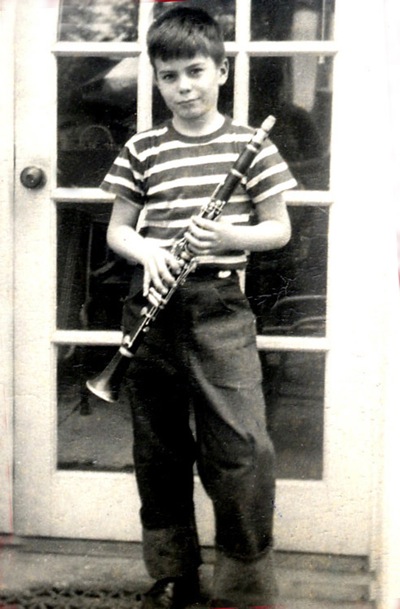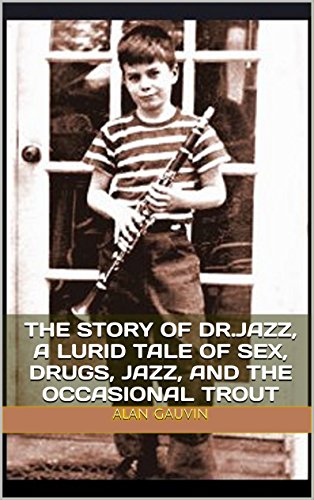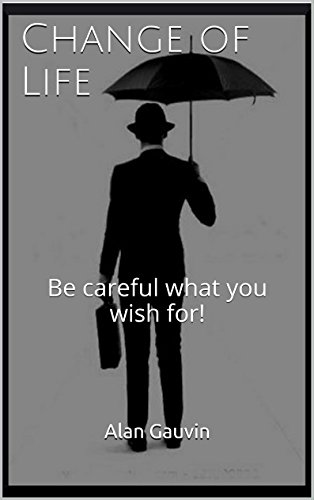First Spark & The Lair of the Creature: Part 1
Maine Cat
by Guest Columnist, Alan Gauvin
![]() HOULTON, Me—(Weekly Hubris)—11/8/10—That jazz caught my ear as a youngster is scarcely odd, since both parents were huge fans. More to the point, they enjoyed most kinds of music but were particularly fond of jazz and standards, the two, happily, being infinitely interchangeable.
HOULTON, Me—(Weekly Hubris)—11/8/10—That jazz caught my ear as a youngster is scarcely odd, since both parents were huge fans. More to the point, they enjoyed most kinds of music but were particularly fond of jazz and standards, the two, happily, being infinitely interchangeable.
Aside from taking up the clarinet at age six, little else of significance happened in my early years other than wonderful summers in Maine, tonsillitis, assorted allergies, a bout with whooping cough, cavity-prone teeth, a third-degree sunburn with blisters the size of buttermilk pancakes, and a variety of pox. I did however discover what my penis was really for, and the race was on to certain blindness.
Seventh grade marked the beginning of my shared creative life. I’d been drawing, painting, and playing clarinet for half my years and, at age 12, I began to cultivate a certain mystique among my classmates which, by the time I reached my senior year, was parlayed into being voted both class artist and class musician.
Thanks to Dad’s radio persona and involvement in the art world, our home served as a meeting place for musicians and other creative souls of distinction. I’d love to amuse you with anecdotes about Morey Amsterdam, Bob and Ray, Louis Armstrong, Sid Caesar, Richard Basehart, Imogene Coca, cartoonists Robert Osborn and Mischa Richter, Rosemary Clooney, or Jack Kerouac, to drop just a few names, but I was too young to pay much attention and, by the time I was old enough to care, most had left the scene one way or another.
I asked my brother Peter, a teenager at the time already playing trumpet, for some in-put regarding those days and the wonderful get-togethers, but he got pissed at me just for asking. Something about hating our parents or some damn thing. Seems like a big waste of energy to me and way past time to get over it.
Of the countless musicians in and out, the strongest influences on me were trombonist Wilbur DeParis; his brother, Sidney, on cornet, trumpet, and some sort of tuba; along with their longtime clarinetist, Omer Simeon, who made a mean Shrimp Creole and equally amazing bouillabaisse; and the man most responsible for first nurturing my desire to play jazz, Edmond Hall.
 I was five; it was my first time hearing a live band in a club, sitting at the broadcast desk with Dad, maybe ten feet from Ed, my eyes wide open and mouth agape. The intensity of Hall’s playing was overwhelming, and he made everyone in the room feel fucking great. Perhaps it was on that level that I first thought about playing. If the listener feels that good, how must the performer feel? Like some lesser god, perhaps.
I was five; it was my first time hearing a live band in a club, sitting at the broadcast desk with Dad, maybe ten feet from Ed, my eyes wide open and mouth agape. The intensity of Hall’s playing was overwhelming, and he made everyone in the room feel fucking great. Perhaps it was on that level that I first thought about playing. If the listener feels that good, how must the performer feel? Like some lesser god, perhaps.
I couldn’t have had better role models than Omer and Ed, both remarkable players. It was Ed who took me to George Napolean’s shop and picked out a clarinet for me. Naturally, the folks were thrilled. I was thrilled, too, in a six-year-old kind of way. This axe was way more cool than the three-dollar toy clarinet I’d been picking out tunes on for the year since I first heard Ed play, but I didn’t have a clue what an opportunity I was being handed so, naturally, took it all as kids tend to do: I wanted to climb trees, play ball, and go fishing.
Although I’ve come to do many things well, I can’t remember ever working hard learning to do so. Generally speaking, if I see it done, I can do it. As a consequence, I’ve always taken whatever I’m doing entirely for granted. Why should the clarinet have been any different? As I quickly discovered, however, the physical nature of the clarinet made it almost impossible to take it for granted, and because my love of music was essentially no more important to me than my love of art, science, or catching a fish, I had a predisposition toward the lackadaisical and a serious problem applying myself.
Notwithstanding a profoundly casual attitude toward all things, which would ensure I’d never become a clarinet virtuoso, I did learn to get a fat pleasant sound on the instrument; how to read, swing, and how to use my ears.
Born at the turn of the last century, it’s safe to assume Ed learned to improvise entirely by ear. After all, there were no “jazz schools” when he was growing up in New Orleans, and he never made any suggestions regarding how to improvise. He left it to me to exercise my ears, develop my sense of relative pitch, and witness whatever popped out. I wasn’t made aware of an academic approach to improvisation until I reached high school and, by then, I was comfortable relying on my ears and industriously resisted altering my course.
Admittedly, I am a dinosaur. Virtually no one learns to play strictly by ear any more. Prior to the current plethora of jazz academies obsessed with analyzing every note played, a trip down the jazz path was a far more innocent, unadulterated journey resulting in an amazing diversity of intensely personal styles. You could actually tell one saxophonist from another. Sad to say, there are few innovators any longer, and not much diversity. Had this academic “assembly line” approach been prevalent when Omer and Ed started playing, they would likely not have developed two such divergent styles, and jazz would be poorer for it.
These days, vast legions of marginally capable wannabe’s with little or no genuine connection to the music are herded into these schools and conned into believing there will be work for them after they are systematically trained to approach improvisation from a wholly mechanical, non-spontaneous point of view. That ain’t jazz, folks.
As I entered the seventh grade, we’d been living in Huntington Long Island a year or so and, although Dad was still in radio, his alter ego, Dr. Jazz, was all but forgotten, with the exception of a couple of DJ’s to follow who would steal his moniker.
My meager talent as a jazz clarinetist didn’t escape the notice of my new school’s band director, Clem DeRosa, well known for his efforts to introduce young people to jazz. The first ensemble of note he created was, I believe, the very first elementary school jazz band. Instrumentation was limited by the children’s inability physically to manage the larger instruments, but it was a credible ensemble nonetheless which Clem recorded for posterity. As these kids moved up in grades, so did he. By the time I met him in seventh grade he had a full blown big band, one of very few such school bands in existence at the time, preserved on yearly LP’s.
Since I was not yet playing saxophone, Clem formed a “Dixieland” band around me. I became a member of his unique cadre and featured in my own ensemble. Heady stuff, and my first taste of recording and public performance.
Then, closing in on summer, he sent me home with one of the school’s alto saxophones. Why couldn’t the clarinet have been this easy to play? This axe I could take for granted. I was in my element.
Thanks to my Dad’s enormous collection of recordings, I had countless saxophonists to inspire me. There were traditionalists as well as purveyors of swing, bop, and emerging modernists and, just two months later, as the eighth grade began, I was getting a really good sound on the thing and had already developed a great deal more facility on the alto than the clarinet. I continued to play clarinet in the concert band and began playing alto in the big band, leaving the “Dixie” behind, or so I thought.
At age 17, an extraordinary thing happened. Wilbur DeParis asked Dad if I could take a brief sabbatical from school to join a tour with his “New” New Orleans Jazz Band. Garvin Bushel was unable to make the tour and Wilbur, to my amazement, was serious. I had added soprano and baritone saxes to my arsenal as well as bass clarinet, but hadn’t touched the other clarinet for months. In addition, the band was an intensely swinging, very tightly knit group lightyears beyond my sophomoric abilities but, despite my trepidation, I couldn’t refuse Wilbur, who was like a second father to me.
Having grown up listening to the band, I was familiar with most of their arrangements, but the first rehearsal proved somewhat rough. I suggested I might be more comfortable playing soprano sax, but Wilbur assured me I sounded just fine on clarinet. After two rehearsals, with my heart in my throat and damp shorts, I hit the road.
After the first traumatic walk on stage and a couple of tunes with these guys, I began to relax and even enjoy myself a bit. Fears of being booed off the stand didn’t materialize, and I began to think there was hope after all.
The day after my debut, a review came out in the local paper which I was sure I didn’t want to read but, to my great surprise and relief, the reviewer, a big fan of Garvin’s, was quite charitable and, as the tour progressed, I gained more confidence, my chops becoming less of an issue.
The last stop on the tour was a week in Toronto before returning to NY and the relative security of father and friends. As it happened, Duke’s band was in town as well and many of his crew fell by to say hello, but two in particular made a profound impression on me.
Russell Procope and “Cat” Anderson wandered in and, after the set, I was introduced and spent the break listening to stories the guys were sharing. Russell and Cat were complimentary and attentive to me and, after the gig, invited me to grab some grub. Wilbur was cool with it, so off we went. After we ate and returned to the hotel, I invited them to my room where I had a record player and a few choice sides. Of course, they had the obligatory “jug” and, inevitably, I suppose, I was offered a taste. I didn’t care much for it, having tasted both liquor and beer at home, and preferring the taste of beer over hard stuff. It was a dreadful idea but I, being a stupid kid on the road for the first time and not to be outdone, got stinkin’ drunk. Next on the menu was a “funky” cigarette. This, it turned out, was a “really” dreadful idea. I spewed chunks everywhere; the record player would never be the same. My guests seemed to find this all very amusing as they cleaned me up and poured me into bed.
The next morning, at an hour I’m sure was agony for them, they returned to nurse me through the inevitable hangover and see to it I was on the bandstand that night none the worse (and Wilbur none the wiser).
Following a quick puke, a cold shower, and some aspirin, they took me to breakfast. Afterwards, we set out on a long leisurely walk about town. Passing a hat store, Stetsons and such, Cat remarked, “The kid needs a hat,” and so in we went. After I’d tried on a couple of dozen, Cat chose one he thought perfect for me. It was black leather with a narrow, upturned brim. Glorious: a classic jazz “lid.”
My first professional tour over, seed firmly rooted, and the jazz “mystique” indelibly scorched into my psyche, I returned to NY and resumed my schooling. Sad to say, I never ran into Russell or Cat again.
In hindsight, notwithstanding my determined drug and alcohol use, it’s a wonder I didn’t become more seriously messed up than I am, for aside from the obvious opportunities afforded me by my father’s place in the arts, my early years were spent in a family nightmare that made Virginia Woolf’s life seem tame by comparison
(Part 2 to follow . . .)

To order copies of Alan Gauvin’s books, The Story of Dr. Jazz, a Lurid Tale of Sex, Drugs, Jazz, and the Occasional Trout, or Change of Life: Be careful what you wish for!, from Amazon, click on the book cover below.


2 Comments
James Asmussen
Hi, Alan. I played trombone along with Walter Pryce and always wondered where those notes came from that sounded so right. I’m enjoying reading your stuff on the internet – I got the link from John Dusenbury.
Also wondering what it was like in the Buddy Rich band, and if you have ever played with Steve Gadd. I guess Clem taught me inadvertently about the meaning of time, though I know more than once, I confused beat one for beat two. Got to admit, Steve Gadd is my hero.
James
alan gauvin
I did play with Steve, James, on the Bill Watrous band. Did I hear you are somewhere in Maine?